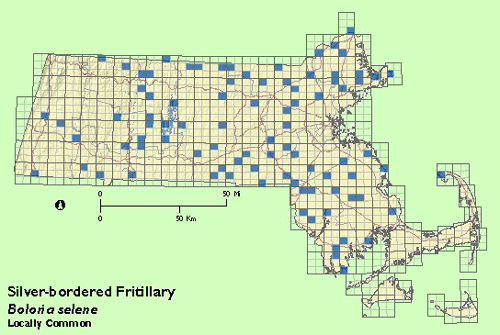Butterfly Atlas
Find a Butterfly
Silver-bordered Fritillary
Boloria selene
Named
Denis and Schiffermuller, 1775

Taxonomy & Nomenclature
The English name of the European race of this species is Small Pearl-bordered Fritillary.
Identification
Wingspan: 1 3/8 - 2". A small black and orange butterfly superficially similar to Pearl Crescent, Harris‘ Checkerspot and Meadow Fritillary. In all of these cases the present species can be distinguished by the even marginal row of silver spots on the hindwing below and the irregular pattern of larhe, silver, roughlt rectangular spots closer to the base of the hindwing. Above Pearl Cresent and Harris‘ Checkerspot have much broader black margins on all wings than this fritillary.
Distribution
Holarctic. In North America, found from central Alaska east through southern Canada to Labrador and Newfoundland; southward to Oregon, New Mexico, Illinois, Maryland, and the North Carolina mountains. Throughout New England.
Status in Massachusetts
During the Atlas period this species was found to be locally common throughout the Commonwealth with the notable exceptions of Berkshire County, greater Boston, and Cape Cod and the islands (see Notes). Maximum: 150, Stoughton (Bristol Co.), 8 August 1992.

Flight Period in Massachusetts
Two to three flights. In southern portions, broods hatch in May, July and September while in extreme northern and western areas there are two flights only . Flight periods may overlap. Extreme dates: 4 May 1986, Petersham (Worcester Co.), T. Tyning, and 30 September, 1994, Sudbury (Middlesex Co.), T. Dodd.
Larval Food Plants
Violets (Viola spp.). Lance-leaved Violet (V. lanceolata) is often abundant in selene‘s preferred wet-meadow habitat.
Adult Food sources
Found at 21 species of flowers during Atlas period. Opler and Krizek (1984) note a preference for composites.

Habitat
Wet or moist meadows typically dominated by sedges. Also brushy swamps and bogs. Strays to dry meadows and roadsides in immediate vicinity.
Life Cycle
EGG: Pale yellow or greenish white; barrel shaped with many longitudinal ribs. OVIPOSITION: Eggs laid near but often not on violets. LARVA: Olive brown to black with orange brown side stripe; numerous orange yellow spines tipped in black. CHRYSALIS: Brownish with several metallic markings. OVERWINTERING STAGE: Second to fourth instar larva.
Typically seen coursing just over the top of a meadow engaging in frequent interactions with other members of the population. At rest, usually found sunning among grasses rather than on the exposed tops.
Notes
Scudder (1889) indicates that historically the Silver bordered Fritillary was found throughout the state. Kimball and Jones (1943) state that on Natucket this species was "moderately common in wet meadows and boggy places", and on Martha‘s Vineyard it was "regularly present throughout the island, though rarely abundant." Atlas records, however, point to apparent gaps in this species distribution in Berkshire County, Cape Cod and the islands, and to a lesser extent in central Massachusetts (the Worcester plateau). In Berkshire County, where coverage was fairly consistent, there seems to be a real absence. In addition many veteran field lepidopterists agree that the species has undergone significant decline in the last 30 years. The species has also declined "dramatically" in England and "severely" in the Netherlands during a similar time period with speculations that habitat change due to development and intensified agriculture is implicated. With widespread destruction and degradation of small wetlands in Massachusetts it is plausible to conclude that development may also be the culprit here.
Account Author
Richard A. Forster



